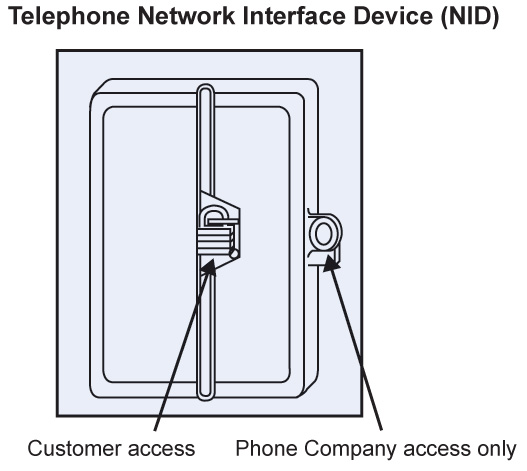Landline Phone Service Trouble
Indiana Office of Utility Consumer Counselor
Picking up your phone and hearing static or silence instead of a dial tone can be annoying and frustrating or may cause even more serious problems. Landline telephone problems occur for a variety of reasons, from problems with the phone company’s lines outside your building to bad wiring or faulty equipment inside your building.
When you experience problems with your phone service, check the Network Interface Device (NID), a small gray box usually located on the outside of your home or business, often near the electric meter. Checking the NID is simple, takes only a few minutes and will determine whether the cause is your responsibility (inside the building) or the phone company’s (outside the building). You might also choose to check with neighbors to see if they are having similar problems.
If a problem is caused by wiring or equipment inside your home or business, you (or the owner of the building) will be responsible for the repair. This may be as simple as purchasing a new phone or installing a new phone jack. You may repair the problem yourself or hire someone else to do so; you are not required to hire the phone company to fix the problem. (See the inside wire maintenance service section below for more information.)
If you determine, through checking the NID and talking with neighbors, that the problem is outside the building, report the matter to your local phone company. The company will advise you of any information it has about the problem and its planned response.
| Warning
This fact sheet provides general information regarding Network Interface Device (NID) units, which vary among companies. To avoid serious bodily injury or damage to the NID, follow all instructions from your local telephone service provider if you open a NID for line testing. There is a risk of electric shock if testing is not done properly and with caution. You should only conduct a NID test when standing on dry ground and in appropriate weather conditions. Be careful when opening and closing the “consumer access” compartment and make sure it is tightly closed when the test is complete. Do not open the “company access only” compartment under any circumstances. The NID is the property of the telephone company. If it is damaged, the company may hold you responsible. |
Testing the NID
 NIDs are installed on most buildings constructed after 1986. If you live or work in an older building and do not have or cannot locate the NID, contact your phone company. The company must install a NID if requested, free of charge, on any residential line or any business account with up to three lines. Contact your local phone service provider for instructions on testing your NID. In general, each NID has two compartments: one for consumer access and another for telephone company access. Before testing the NID, unplug all telephones in your home and carefully read the following instructions and disclaimer.
NIDs are installed on most buildings constructed after 1986. If you live or work in an older building and do not have or cannot locate the NID, contact your phone company. The company must install a NID if requested, free of charge, on any residential line or any business account with up to three lines. Contact your local phone service provider for instructions on testing your NID. In general, each NID has two compartments: one for consumer access and another for telephone company access. Before testing the NID, unplug all telephones in your home and carefully read the following instructions and disclaimer.
1. Open the “consumer access” compartment. For your safety, do not stand in a puddle or any other standing water when testing the NID. Testing the NID during rainfall is not recommended.
2. Plug a working telephone into the appropriate test jack.
3. Wait for a dial tone.
4. Make a local call.
It is important to confirm that the “test” phone is working properly. For example, use the phone to make a call at another home or business to confirm that the phone itself is not causing the problem.
If the problem occurs on the test call, the problem is most likely with the outside line, which is the phone company’s responsibility. If the problem does not occur on the test call, the problem is probably caused by the wiring or equipment inside your home or business.
Inside wire maintenance service plans (IWMS)
Some telephone companies offer inside wire maintenance service (IWMS) plans, which function as “insurance policies” on telephone wiring inside a home or business. The consumer pays a monthly fee and then receives free or reduced cost repairs if and when inside wiring problems develop.
You must decide for yourself whether the monthly cost of an IWMS plan is worth it, considering the potential risk of an inside wire failure or other problem on your property. Before you make a final decision, carefully read the IWMS agreement, understand what the program covers and be aware of applicable labor rates, deductibles and maximum coverage.
If you live or work in rented space, you may not need an IWMS plan, as landlords are generally responsible for wiring on their rental properties. Consumers who rent should consult their lease agreements and/or local laws.
For more information on IWMS and similar plans, please see the OUCC's fact sheet.
Indiana Office of Utility Consumer Counselor
115 W. Washington St., Suite 1500 South
Indianapolis, IN 46204-2215
www.IN.gov/OUCC
uccinfo@oucc.IN.gov
toll-free: 1-888-441-2494
voice/TDD: 317-232-2494
fax: 317-232-5923
3/07
